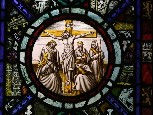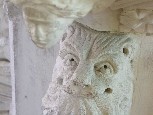| |
|
 |
|
A
surprise, this big church in its wide
unfenced graveyard, in the centre of a
large village. It has all the greater
presence here in high Suffolk, surrounded
as it is by villages with smaller
churches. Around these parts, only Eye is more
imposing. What a pity then, that unlike
most of its neighbours it is kept locked.
So I wrote ten years ago, and coming
back on a stunning, hot day in early June
2010 I found that little had changed. I had cycled down
from Diss, then on through Eye and out to
quiet Redlingfield. After the peace of
that intensely rural spot, I had cut back
through busy Occold and then on into
Thorndon. It is still a substantial
village set along its long street, home
to the local health authority's Kerrison
conference centre, the nearby pub playing
host to the village shop. The strange
south tower of All Saints still imposes,
and the church is still ordinarily kept
locked, I am afraid, although there is a
keyholder notice now.
|
The south tower is
massive, forming an entrance, and the nave stretched either side of
it beyond creates the impression of a gatehouse
to a baronial castle, possibly in the Highlands
of Scotland. The tower is about a century later
than the 13th century nave against which it
stands. In the south wall behind a later
tombchest is a curious tomb alcove. It was
probably the last resting place of Nicholas
Bockland, the donor of the chancel. Why was the tower built
to the south and not to the west? Suffolk has
some thirty-odd south towers, but they are mainly
in the south-east of the county. It may have been
that the ground was too soft to the west, or that
there wasn't room then, although the graveyard
stretches widely to the west today. Perhaps they
simply thought it looked better that way.
I was rather
pleased and intrigued that, on this Friday
morning, a car was parked immediately outside the
entrance, and the church itself was open. I
stepped down into the porch, and then for the
first time, through the double doors into the
church itself. A cheerful lady was inside doing
the flowers, and was very happy for me to come in
and have a look around. She even offered to make
me a cold drink, not least because she was proud
of the church's recent reordering of the west
end, with the pleasing woodwork of the kitchen
and meeting room subtly integrated against the
western wall of the nave. She also told me that
the church was now open one morning a week so
that local people could come in for as cup of tea
and a chat, which seemed a step in the right
direction.
The interior of
All Saints is almost entirely the work of Richard
Phipson,
in 1870. This was one of his last jobs before his
appointment as Diocesan architect, and must have
been a pretty good testimony. As usual with him,
it is mostly safe and sensible, if unexciting.
His crisp use of encaustic tiles in the sanctuary prefigures those of his
masterpiece, Ipswich St Mary le Tower. The reredos is also his
design; Mortlock tells us that it was paid for by
the Poet Laureate Robert Bridges, and carved in
Belgium. Phipson's, too, are the roofs, and most
of the furnishings.
There are a few
medieval survivals. The traditional East Anglian
15th century font is a good one, though
largely recut. The lions around the stem appear
to be stalking the pendant angels below the bowl.
The scattering of medieval glass in the north
chancel is intriguing. Set among it is a roundel
of 16th century Flemish glass depicting the
stripping of Christ. The two thieves who will be
crucified with him sit and look on. Another piece
of continental glass depicts St Peter. There is
also a roundel in the continental style depicting
the crucifixion, but this is actually modern. I
think it probably dates from the 1920s,
suggesting a date for the resetting of this
glass, and may be the work of the Norwich-based
King workshop. It appears to be signed at the
foot of the cross.
| Perhaps
the most interesting thing here is the
brass inscription set in the north wall.
It comes from the redundant church at Rishangles, a couple of miles
away. That was was sold off for domestic
use, and is now being refurbished after a
period of dereliction. But the brass was
moved here. It is to Richard Grimeston,
and dated 1599. Looking back at his life
over that theologically eventful century,
it reords that by twice two kings and
queens his life was grac't, but one
religion held from first to last.
This intrigued me, deep as I was into
Hilary Mantell's Wolf Hall: is
it a proud boast of his Protestant
pedigree? Or a quiet hint that he
remained loyal to the Catholic Church
through its darkest days?
|
|
 |
|
|
|

